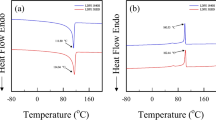Polypropylene (PP) and styrene-butadiene-styrene (SBS) blends with different mass fractions were prepared in a molten state using a twin-screw extruder. The effect of SBS content on the microstructure and properties of PP/SBS was discussed by studying the morphology and mechanical properties of PP/SBS outdoor aging samples, using differential scanning calorimeter, universal material testing machine, capillary rheometer, X-ray diffraction and X-ray photoelectron spectrometer. The results show that the best performance of unaged composites is 20% PP/SBS composites without added compatibilizer. Low temperature test combined with dynamic thermal analysis found that the addition of SBS effectively improved the low temperature brittleness of PP. XRD tests indicate that SBS can promote the formation of β crystals in PP. Indoor and outdoor aging tests show that samples with 30% of SBS has excellent long-term anti-aging properties.






Similar content being viewed by others
References
F. A. Ghasemi, S. Daneshpayeh, I. Ghasemi, and M. Ayaz, “An investigation on the Young’s modulus and impact strength of nanocomposites based on polypropylene/ linear low-density polyethylene/titan dioxide (PP/LLDPE/TiO2) using response surface methodology,” Polym. Bull., 73, No. 6, 1741–1760 (2016).
M. Khodabandelou and M. K. R. Aghjeh, “Impact behavior of CNT-filled PP/EPDM blends: effect of dynamic vulcanization and PP-g-MA compatibilizer,” Polym. Bull., 73, No. 6, 1607–1626 (2016).
X. J. Lai, S. Tang, H. Q. Li, and X. R. Zeng, “Flame-retardant mechanism of a novel polymeric intumescent flame retardant containing caged bicyclic phosphate for polypropylene,” Polym. Degrad. Stabil., 113, 22–31 (2015).
P. A. Zapata, F. M. Rabaliati, I. Lieberwirth, et al., “Study of the photodegradation of nanocomposites containing TiO2 nanoparticles dispersed in polyethylene and in poly(ethylene-co-octadecene),” Polym. Degrad. Stabil., 109, 106–114 (2014).
Y. M. Li, G. X. Wei, and H. J. Sue, “Morphology and toughening mechanisms in clay-modified styrene-butadiene-styrene rubber-toughened polypropylene,” J. Mater. Sci., 37, No. 12, 2447–2459 (2002).
P. Raghu, C. K. Nere, and R. N. Jagtap, “Effect of styrene–isoprene–styrene, styrene–butadiene–styrene, and styrene–butadiene–rubber on the mechanical, thermal, rheological, and morphological properties of polypropylene/polystyrene blends,” J. Appl. Polym. Sci., 88, No. 2, 266–277 (2003).
Y. Li, J. T. Huang, X. Lu, et al., “Influences of dicumyl peroxide on morphology and mechanical properties of polypropylene/poly(styrene-b-butadiene-b-styrene) blends via vane-extruder,” J. Appl. Polym. Sci., 132, No. 9 (2015), DOI: https://doi.org/10.1002/app.41543.
S. M. Al-Salem, B. K. Sharma, A. R. Khan, et al., “Thermal degradation kinetics of virgin polypropylene (PP) and PP with starch blends exposed to natural weathering,” Ind. Eng. Chem. Res., 56, No. 18, 5210–5220 (2017).
J. González, C. Albano, M. V. Candal, et al., “Characterization of blends of PP and SBS vulcanized with gamma irradiation,” Nucl. Instrum. Meth. B, 236, Nos. 1–4, 354–358 (2005).
M. Saroop and G. N. Mathur, “Studies on dynamically vulcanized polypropylene (PP)/butadiene styrene block copolymer (SBS) blends: Crystallization and thermal behavior,” J. Appl. Polym. Sci., 71, No. 1, 151–161 (1999).
P. Lin, W. D. Huang, N. P. Tang, and F. P. Xiao, “Performance characteristics of terminal blend rubberized asphalt with SBS and polyphosphoric acid,” Constr. Build. Mater., 141, 171–182 (2017).
N. Nciri, N. Kim, and N. Cho, “New insights into the effects of styrene-butadiene- styrene polymer modifier on the structure, properties, and performance of asphalt binder: The case of AP-5 asphalt and solvent deasphalting pitch,” Mater. Chem. Phys., 193, 477–495 (2017).
A. K. Swamy, U. D. Rongali, and P. K. Jain, “Effect of HDPEH polymer on viscoelastic properties of SBS modified asphalt,” Constr. Build. Mater., 136, 230–236 (2017).
C. Xin, Q. Lu, C. Ai, et al., “Optimization of hard modified asphalt formula for gussasphalt based on uniform experimental design,” Constr. Build. Mater., 136, 556– 564 (2017).
M. Wang and L. P. Liu, “Investigation of microscale aging behavior of asphalt binders using atomic force microscopy,” Constr. Build. Mater., 135, 411–419 (2017).
L. Sun, X. T. Xin, and J. L. Ren, “Asphalt modification using nano-materials and polymers composite considering high and low temperature performance,” Constr. Build. Mater., 133, 358–366 (2017).
P. Wang, Z. J. Dong, Y. Q. Tan, and Z. Y. Liu, “Effect of multi-walled carbon nanotubes on the performance of styrene–butadiene–styrene copolymer modified asphalt,” Mater. Struct., 50, 17 (2017), DOI: https://doi.org/10.1617/s11527-016-0890-9.
W. Yin, F. Ye, and H. Lu, “Establishment and experimental verification of stability evaluation model for SBS modified asphalt: Based on quantitative analysis of microstructure,” Constr. Build. Mater., 131, 291–302 (2017).
Y. Y. Wang, L. Sun, and J. Zhou, “Pavement performance evaluation of recycled styrene–butadiene–styrene-modified asphalt mixture,” Int. J. Pavement Eng., 18, No. 5, 404–413 (2017).
J. Y. Pang, S. J. Du, R. T. Chang, and Q. Pei, “The properties of SBS-modified asphalt binder in the presence of dithiodimorpholine and tetraethyl thiuram disulphide,” Road Mater. Pavement, 17, No. 2, 466–476 (2016).
J. Tocháček and Z. Vrátničková, “Polymer life-time prediction: The role of temperature in UV accelerated ageing of polypropylene and its copolymers,” Polym. Test., 36, 82–87 (2014).
D. D. Song, J. Gao, X. G. Li, and L. Lu, “Evaluation of aging behavior of polypropylene in natural environment by principal component analysis,” Polym. Test., 33, 131–137 (2014).
X. Xu, J. Y. Yu, C. L. Zhang, et al., “Investigation of aging behavior and thermal stability of styrenebutadiene-styrene tri-block copolymer in blends,” Polymer (Korea), 40, No. 6, 947–953 (2016).
Acknowledgements
The authors wish to acknowledgement the financial support of the National Natural Science Foundation of China (Nos. 21474082 and 21364014).
Author information
Authors and Affiliations
Corresponding author
Additional information
Translated from Problemy Prochnosti, No. 5, pp. 115 – 126, September – October, 2018.
Rights and permissions
About this article
Cite this article
Yimit, M., Ni, L., Du, Y. et al. Mechanical and Aging Properties of Polypropylene and Styrene-Butadiene-Styrene Composites Under Outdoor and Indoor Conditions. Strength Mater 50, 788–799 (2018). https://doi.org/10.1007/s11223-018-0024-4
Received:
Published:
Issue Date:
DOI: https://doi.org/10.1007/s11223-018-0024-4




